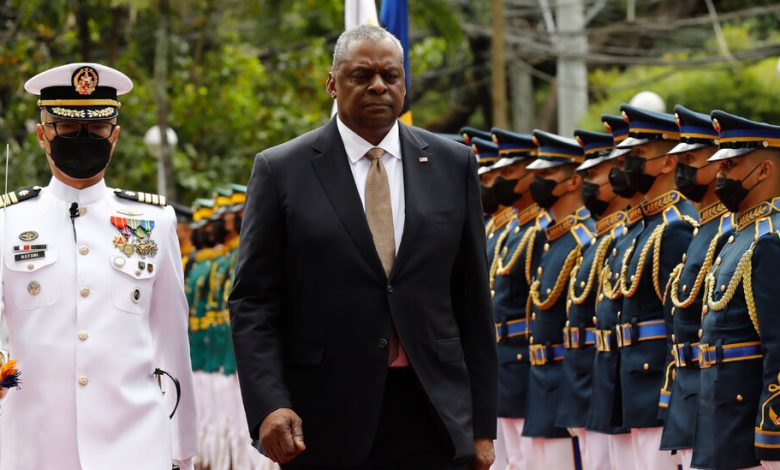A Primer on U.S.-Philippine Military Ties

The United States and the Philippines announced a deal on Thursday that will give U.S. forces access to four more military sites in the Southeast Asian country, creating the largest American military presence there in decades.
The deal, an apparent sign of warming ties between the countries after a six-year rough patch, would have strategic implications if a conflict were ever to break out in Taiwan or the South China Sea.
Here is a brief history of the U.S. military alliance with the Philippines and its complex historical legacy.
How are the two militaries linked?
The Philippines, a former Spanish colony that gained independence in 1946 after being ruled as an American territory for decades, is the oldest of the United States’ five treaty allies in the region. (The others are Australia, Japan, South Korea and Thailand.) It is also a crucial strategic partner in a region where China has been asserting its military power and building military outposts on contested islands in the South China Sea.
The three main components of the U.S.-Philippine military alliance are a 1951 Mutual Defense Treaty; a 1999 Visiting Forces Agreement that allowed for large-scale military exercises; and a 2014 defense agreement that enabled the American military to station troops and weapons at five sites across the Philippines.
The United States military has also sent Special Operations forces to advise counterterrorism missions in the southern Philippines, where Muslim insurgents have battled the Catholic-majority state for decades.
More on U.S. Armed Forces
- Korean War Wall of Remembrance: Many names of American service members who died in the conflict are misspelled or missing from the new memorial wall in Washington, relatives and researchers say.
- Parental Leave: The Pentagon announced a new policy that would double the amount of leave that is available to military service members.
- Defense Bill: Congress passed a $858 billion defense bill that would rescind the coronavirus vaccine mandate for troops and increase the defense budget $45 billion over President Biden’s request.
- A Boost for the N.R.A.: Instructors in military-sponsored J.R.O.T.C. classes have offered to promote the gun rights organization in high schools in exchange for money for their marksmanship programs.
A fraught colonial legacy
The Philippines once hosted some of America’s largest overseas military facilities. But the idea of hosting foreign troops in the country was politically sensitive, because many Filipinos saw the arrangement as a vestige of American colonialism.
In 1992, the United States had to vacate Subic Bay, its last base in the country, after street protests and the Philippine Senate’s decision to sunset America’s military presence. Subic Bay is near the South China Sea and was once home to a major U.S. naval contingent during the Cold War.
The 1999 and 2014 agreements allowed the American military to rebuild its presence in the Philippines to some degree. But when President Rodrigo Duterte took office in 2016, he said he wanted to end the former, and potentially revoke the latter, as part of a “separation” with the United States and a move toward better relations with China.
Warming U.S.-Philippine ties
Mr. Duterte eventually backed off his threats, and his successor, President Ferdinand Marcos Jr., has sought to revive the relationship with the United States since taking office last year. The agreement announced on Thursday is a big step in that direction.
Specifically, it would extend the 2014 agreement by allowing Washington to position military equipment and rotate its troops into a total of nine Philippine military sites, up from four in the original, 10-year deal. The change will essentially allow the United States to establish its largest military presence in the country in 30 years.
Why does the new deal matter?
The extension of the 2014 pact, the Enhanced Defense Cooperation Agreement, could have implications for the future of Taiwan, the island democracy near China that Beijing claims as its territory.
Tensions over Taiwan have been rising since then-House Speaker Nancy Pelosi visited last summer. That contentious move prompted Beijing to step up its activity in the area with several days of live-fire drills, raising the specter of a future conflict.
American officials say that getting access to the Philippines’ northernmost islands is crucial to countering China in the event of an attack on nearby Taiwan. One of the islands, Luzon, the country’s most populous, has military facilities that can accommodate American troops and fighter planes.
The new agreement could also have implications in the South China Sea, which is home to some of the world’s busiest shipping lanes.
Even though an international tribunal found in 2016 that Beijing’s expansive claim to sovereignty over the sea had no legal basis, the Chinese military buildup there has continued. The Philippines is one of several Southeast Asian nations, including Indonesia and Vietnam, that want American help in fending off that buildup.
